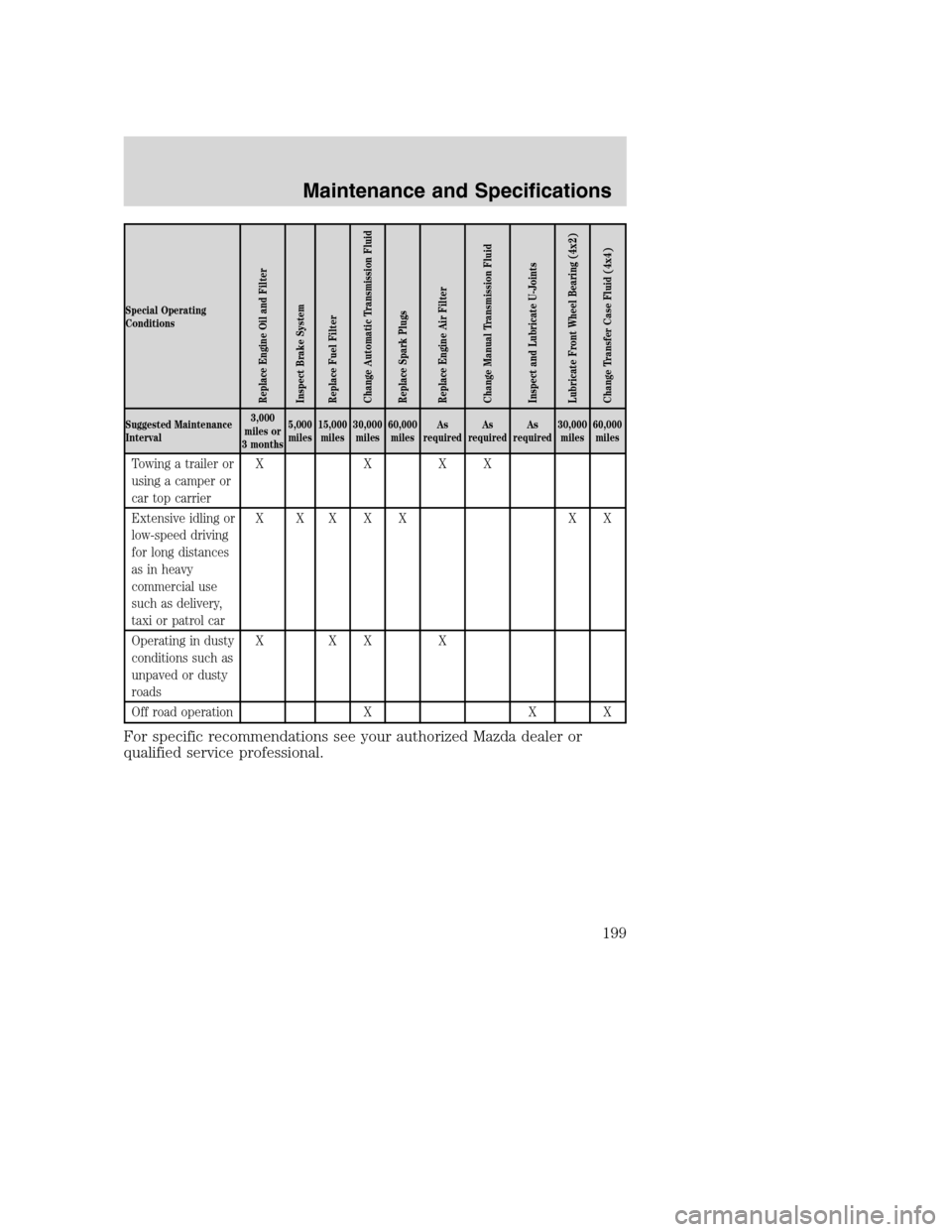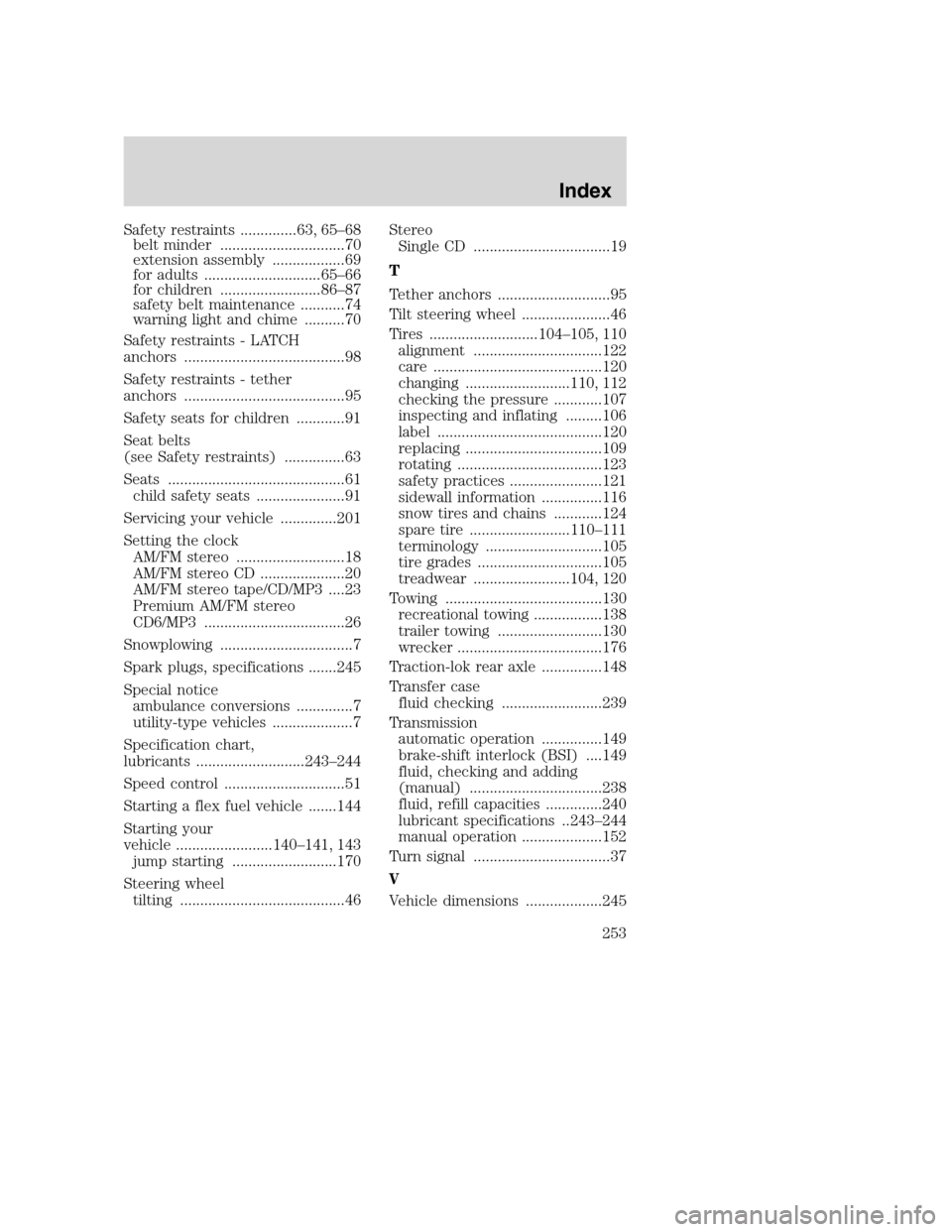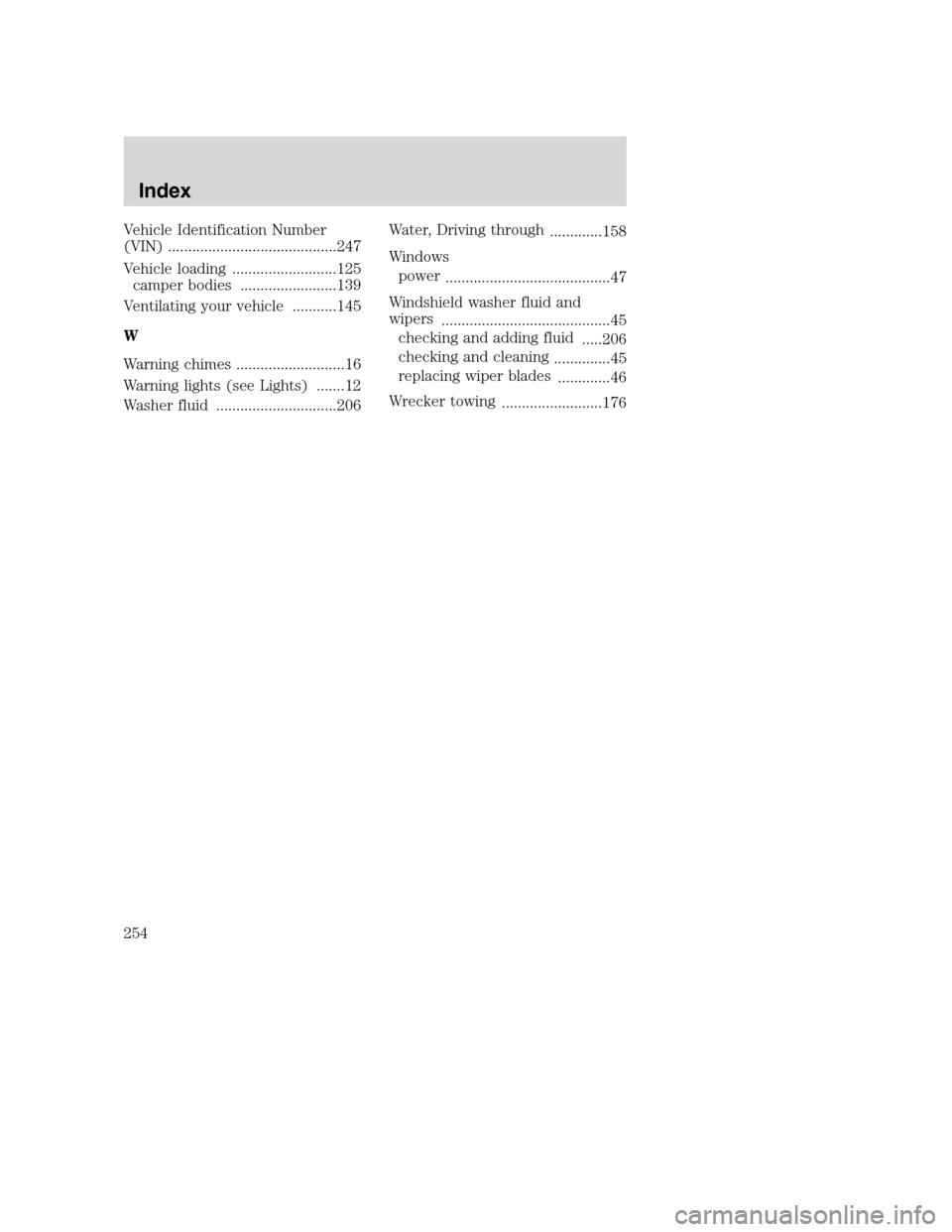tow MAZDA MODEL B-SERIES 2005 (in English) Service Manual
[x] Cancel search | Manufacturer: MAZDA, Model Year: 2005, Model line: MODEL B-SERIES, Model: MAZDA MODEL B-SERIES 2005Pages: 254, PDF Size: 2.13 MB
Page 193 of 254

INTRODUCTION
Be extremely careful to prevent injury to yourself and others or damage
to your vehicle when using this manual for inspection and maintenance.
If you’re unsure about any procedure it describes, we strongly urge you
to have a reliable and qualified service shop perform the work, preferably
an Authorized Mazda Dealer.
Factory-trained Mazda technicians and genuine Mazda parts are best for
your vehicle. Without this expertise and the parts that have been
designed and made especially for your Mazda, inadequate, incomplete,
and insufficient servicing may result in problems. This could lead to
vehicle damage or an accident and injuries.
For expert advice and quality service, consult an Authorized Mazda
Dealer.
The owner should retain evidence that proper maintenance has been
performed as prescribed.
Claims against the warranty resulting from lack of maintenance, as
opposed to defective materials or authorized Mazda workmanship, will
not be honored.
Any auto repair shop using parts equivalent to your Mazda’s original
equipment may perform maintenance.But we recommend that it
always be done by an Authorized Mazda Dealer using genuine
Mazda parts.
SCHEDULED MAINTENANCE
Schedule 1 — Normal Driving Conditions/Emission Control
Systems
Follow Schedule 1 if the vehicle is operated mainly where none of the
following conditions apply. If any do apply, follow Schedule 2.
•Reapeated short-distance driving.
•Driving in dusty conditions.
•Towing a trailer.
•Operating in hot weather in stop-and-go “rush hour” traffic.
•Exntended periods of idling or low-speed operation.
•High-speed operation with a fully loaded vehicle.
•Off-road operation.
NOTE:After the described period, continue to follow the described
maintenance at the recommended intervals.
REVIEW COPY
2005 Mazda B Series(mbs), Owners Guide (post-2002-fmt)(own2002),
Market:Canadian_French(fr_can)
Maintenance and Specifications
Maintenance and Specifications
193
Page 198 of 254

*3 At 60,000 miles (96,000 km), the dealer will replace the PCV valve at
no cost, except Canada and California vehicles.
*4 Refer to vehicle emission control information label for spark plug and
gap specifications.
*5 The California Air Resources Board has determined that the failure to
perform this maintenance item will not nullify the emission warranty nor
limit recall liability prior to completion of the vehicle’s useful life.
SCHEDULE 2 — SPECIAL OPERATING CONDITIONS
If your driving habitsFREQUENTLYinclude one or more of the
following conditions:
•Short trips of less than 10 miles (16 km) when outside temperatures
remain below freezing.
•Towing a trailer, or carrying maximum loads.
•Operating in severe dust conditions.
•Operating duringhot weatherin stop-and-go “rush hour” traffic.
•Extensive idling, such as police, taxi or door-to-door delivery service.
•High speed operation with a fully loaded vehicle (max. GVW).
•Off-road operation
Change ENGINE OIL AND OIL FILTER every 3 months or 3,000 miles
(4,800 km) whichever occurs first.
NOTE:Idling the engine for extended periods will accumulate more
hours of use on your vehicle than is actually indicated by the mileage
odometer. Consequently, the odometer reading can be often misleading
when determining the right time to change your engine oil and filter. If
you are using your vehicle in a manner which allows it to remain
stationary while the engine is running for long periods (door-to-door
delivery, taxi, police, power/utility company trucks, or similar duty), then
Mazda recommends you increase the frequency of oil and filter changes
to an interval equivalent to 200 ENGINE HOURS or use. Since most
vehicles are not equipped with hour-meters, it may be necessary for you
to approximate your idle time and plan oil/filter changes accordingly.
REVIEW COPY
2005 Mazda B Series(mbs), Owners Guide (post-2002-fmt)(own2002),
Market:Canadian_French(fr_can)
Maintenance and Specifications
198
Page 199 of 254

Special Operating
Conditions
Replace Engine Oil and Filter
Inspect Brake System
Replace Fuel Filter
Change Automatic Transmission Fluid
Replace Spark Plugs
Replace Engine Air Filter
Change Manual Transmission Fluid
Inspect and Lubricate U-Joints
Lubricate Front Wheel Bearing (4x2)
Change Transfer Case Fluid (4x4)
Suggested Maintenance
Interval3,000
miles or
3 months5,000
miles15,000
miles30,000
miles60,000
milesAs
requiredAs
requiredAs
required30,000
miles60,000
miles
Towing a trailer or
using a camper or
car top carrierXXXX
Extensive idling or
low-speed driving
for long distances
as in heavy
commercial use
such as delivery,
taxi or patrol carX XXXX XX
Operating in dusty
conditions such as
unpaved or dusty
roadsXXX X
Off road operation X X X
For specific recommendations see your authorized Mazda dealer or
qualified service professional.
REVIEW COPY
2005 Mazda B Series(mbs), Owners Guide (post-2002-fmt)(own2002),
Market:Canadian_French(fr_can)
Maintenance and Specifications
199
Page 220 of 254

•Refer to the chart on the coolant container to ensure the
coolant concentration in your vehicle will provide adequate
protection at the temperatures in which you drive.
Vehicles driven year-round in non-extreme climates should use a 50/50
mixture of engine coolant and distilled water for optimum cooling system
and engine protection.
What you should know about Limp to Safety cooling (2.3L I4
engine only)
If the engine coolant supply is depleted, this feature allows the vehicle to
be driven temporarily to a place of safety. The distance it can be driven
depends on ambient temperatures, vehicle load and terrain, so when the
engine drops into this mode, it is because the engine has overheated and
you need to take special care to avoid it shutting down.
How Limp to Safety works
If the engine begins to overheat:
•The engine coolant temperature
gauge will move to the red (hot)
area.
•The
symbol will illuminate.
•TheCheck engineindicator light
will illuminate.
If the engine reaches a preset over-temperature condition, the engine
will automatically switch to alternating cylinder operation. Each disabled
cylinder acts as an air pump and cools the engine.
When this occurs the vehicle will still operate. However:
•The engine power will be limited.
•The air conditioning system will be disabled.
This system has given you an early warning of engine damage and you
should immediately drive to a place of safety where the engine can be
cooled or the vehicle towed to a service shop. Continuing to drive in this
Limp to Safety mode will increase engine temperature some more,
increasing the chance of engine damage, and:
•The engine will completely shut down.
•Steering and braking effort will increase.
If you have decided not to have the vehicle towed, and when the engine
temperature cools, you try to re-start it and it appears to have returned
REVIEW COPY
2005 Mazda B Series(mbs), Owners Guide (post-2002-fmt)(own2002),
Market:Canadian_French(fr_can)
Maintenance and Specifications
220
Page 221 of 254

to normal operation, don’t delay in getting to a service facility as soon as
possible to diagnose what caused the overheat and prevent further
engine damage.
When Limp to Safety mode is activated
You have limited engine power when in the Limp to Safety mode, so
drive the vehicle with caution. The vehicle will not be able to maintain
high speed operation and the engine will run rough. Remember that the
engine is capable of completely shutting down automatically to prevent
engine damage, therefore:
1. Pull off the road as soon as safely possible and turn off the engine.
2. Arrange for the vehicle to be taken to a service facility.
3. If this is not possible, wait for the engine to cool down.
4. When the engine has cooled down, first check the coolant level. If
low, then use a rag and carefully turn the cap one notch
counter-clockwise carefully to avoid being burned by hot steam.
When there is no steam, keep you face back as you carefully remove
the cap and then replenish the coolant to the full line.
WARNING: Never remove the coolant reservoir cap while the
engine is running or hot.
5. Replace the cap and see if the engine starts and runs normally and
drive it to a service place under reduced load and with the air
conditioning off. If it quickly goes into Limp to Safety mode again,
shut it down in a safe location and have the vehicle towed for
service.
WHAT YOU SHOULD KNOW ABOUT AUTOMOTIVE FUELS
Important safety precautions
WARNING: Do not overfill the fuel tank. The pressure in an
overfilled tank may cause leakage and lead to fuel spray and
fire.
WARNING: The fuel system may be under pressure. If the fuel
filler cap is venting vapor or if you hear a hissing sound, wait
until it stops before completely removing the fuel filler cap.
Otherwise, fuel may spray out and injure you or others.
REVIEW COPY
2005 Mazda B Series(mbs), Owners Guide (post-2002-fmt)(own2002),
Market:Canadian_French(fr_can)
Maintenance and Specifications
221
Page 230 of 254

•Warming up a vehicle on cold mornings is not required and may
reduce fuel economy.
•Resting your foot on the brake pedal while driving may reduce fuel
economy.
•Combine errands and minimize stop-and-go driving.
Maintenance
•Keep tires properly inflated and use only recommended size.
•Operating a vehicle with the wheels out of alignment will reduce fuel
economy.
•Use recommended engine oil. Refer toLubricant specificationsin
this chapter.
•Perform all regularly scheduled maintenance items. Follow the
recommended maintenance schedule and owner maintenance checks
found in your vehicle service maintenance section.
Conditions
•Heavily loading a vehicle or towing a trailer may reduce fuel economy
at any speed.
•Carrying unnecessary weight may reduce fuel economy (approximately
0.4 km/L [1 mpg] is lost for every 180 kg [400 lb] of weight carried).
•Adding certain accessories to your vehicle (for example bug
deflectors, rollbars/light bars, running boards, ski/luggage racks) may
reduce fuel economy.
•Using fuel blended with alcohol may lower fuel economy.
•Fuel economy may decrease with lower temperatures during the first
12–16 km (8–10 miles) of driving.
•Driving on flat terrain offers improved fuel economy as compared to
driving on hilly terrain.
•Transmissions give their best fuel economy when operated in the top
cruise gear and with steady pressure on the gas pedal.
•Four-wheel-drive operation (if equipped) is less fuel efficient than
two-wheel-drive operation.
•Close windows for high speed driving.
EPA window sticker
Every new vehicle should have the EPA window sticker. Contact your
dealer if the window sticker is not supplied with your vehicle. The EPA
window sticker should be your guide for the fuel economy comparisons
with other vehicles.
REVIEW COPY
2005 Mazda B Series(mbs), Owners Guide (post-2002-fmt)(own2002),
Market:Canadian_French(fr_can)
Maintenance and Specifications
230
Page 253 of 254

Safety restraints ..............63, 65–68
belt minder ...............................70
extension assembly ..................69
for adults .............................65–66
for children .........................86–87
safety belt maintenance ...........74
warning light and chime ..........70
Safety restraints - LATCH
anchors ........................................98
Safety restraints - tether
anchors ........................................95
Safety seats for children ............91
Seat belts
(see Safety restraints) ...............63
Seats ............................................61
child safety seats ......................91
Servicing your vehicle ..............201
Setting the clock
AM/FM stereo ...........................18
AM/FM stereo CD .....................20
AM/FM stereo tape/CD/MP3 ....23
Premium AM/FM stereo
CD6/MP3 ...................................26
Snowplowing .................................7
Spark plugs, specifications .......245
Special notice
ambulance conversions ..............7
utility-type vehicles ....................7
Specification chart,
lubricants ...........................243–244
Speed control ..............................51
Starting a flex fuel vehicle .......144
Starting your
vehicle ........................140–141, 143
jump starting ..........................170
Steering wheel
tilting .........................................46Stereo
Single CD ..................................19
T
Tether anchors ............................95
Tilt steering wheel ......................46
Tires ...........................104–105, 110
alignment ................................122
care ..........................................120
changing ..........................110, 112
checking the pressure ............107
inspecting and inflating .........106
label .........................................120
replacing ..................................109
rotating ....................................123
safety practices .......................121
sidewall information ...............116
snow tires and chains ............124
spare tire .........................110–111
terminology .............................105
tire grades ...............................105
treadwear ........................104, 120
Towing .......................................130
recreational towing .................138
trailer towing ..........................130
wrecker ....................................176
Traction-lok rear axle ...............148
Transfer case
fluid checking .........................239
Transmission
automatic operation ...............149
brake-shift interlock (BSI) ....149
fluid, checking and adding
(manual) .................................238
fluid, refill capacities ..............240
lubricant specifications ..243–244
manual operation ....................152
Turn signal ..................................37
V
Vehicle dimensions ...................245
REVIEW COPY
2005 Mazda B Series(mbs), Owners Guide (post-2002-fmt)(own2002),
Market:Canadian_French(fr_can)
Index
253
Page 254 of 254

Vehicle Identification Number
(VIN) ..........................................247
Vehicle loading ..........................125
camper bodies ........................139
Ventilating your vehicle ...........145
W
Warning chimes ...........................16
Warning lights (see Lights) .......12
Washer fluid ..............................206Water, Driving through
.............158
Windows
power
.........................................47
Windshield washer fluid and
wipers
..........................................45
checking and adding fluid
.....206
checking and cleaning
..............45
replacing wiper blades
.............46
Wrecker towing
.........................176
REVIEW COPY
2005 Mazda B Series(mbs), Owners Guide (post-2002-fmt)(own2002),
Market:Canadian_French(fr_can)
Index
254